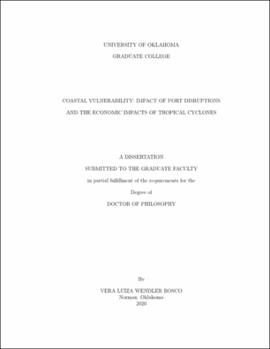| dc.description.abstract | Coastal counties in the United States account for less than 10% of the nation’s land mass. Yet, approximately 40% of the country’s population, or over 127 million people, live in these areas. The population density of coastal counties is 461 people per square mile, much larger than the nation’s average population density of 87 people per square mile. Coasts also present the logistic benefit of allowing the transportation of goods between countries and continents through maritime ports. However, the increase in coastal population and economic activity means an increased exposure and vulnerability to potential natural hazards, such as hurricanes and tropical storms. These weather events are powerful, with the capacity to devastate coastal regions. Therefore, understanding these potentially catastrophic events is critical to assess vulnerability and support informed decision-making at local, state, and federal levels. This research provides valuable insights related to the characteristics of tropical cyclones and to their potential impacts to the coastal United States.
First, an extensive review of the literature related to maritime supply chain resilience and the impacts of port disruptions to the maritime supply chain is performed. Ports are complex enterprises, comprised of a wide variety of stakeholders and subject to risks of many kinds, both man-made and natural hazards. This review allowed the identification of gaps of knowledge to be explored on the topic of maritime supply chain resilience. One of the gaps is the lack of a clearly quantifiable metric for the impacts of one of the most common sources of weather disruptions: hurricane and tropical storms. Albeit the immediate impacts are limited to areas prone to these events, tropical cyclones have been known to impact extensive areas and cause long lasting negative effects.
Second, machine learning is used to rigorously explore and quantify the relationship of tropical cyclone characteristics and their destructive outcomes on the coast of the United States. Historical data on hurricanes and tropical storms is identified and curated to support supervised learning. A novel Storm Damage Ratio is introduced to address the inherent challenge of comparing damage to regions with distinct assets and population. Multiple mathematical models to predict economic impacts from tropical events are created using machine learning methods and the results are compared. Additionally, the storm features that most influence the accuracy of predictions are identified and ranked.
The third research component consists in analyzing coastal vulnerability to tropical cyclones at the state-level by providing mechanisms to account for uncertainty in studying the destructive potential of storms, supporting the decision-making process to improve community resilience. The previously developed concept of Storm Damage Ratio is extended, creating the Local Storm Damage Ratio, which assess the destructive potential of storms with respect to intrinsic characteristics, regardless of the local economic characteristics. Multiple machine learning models are developed to predict the value of Local Storm Damage Ratio at a state-level. The most promising machine learning model is used to study the relationship between state and damage, as well as evaluate state preparedness. Finally, this work makes the innovative approach of building state-level empirical fragility curves to tropical storms. The novelty curves are built for three damage levels: minor, moderate, and major damage. | en_US |

